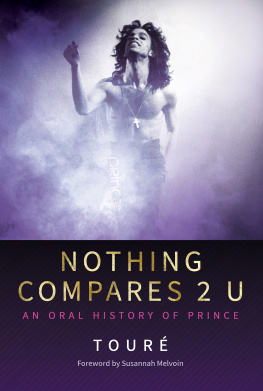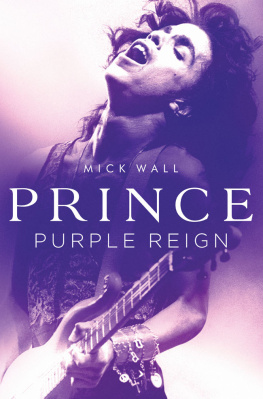Contents
Guide
P rince claimed that digital technology cant be good for you because it packed your head with numbers. But his head often seemed packed with numbers, from the apocalypse of 1999 to the numbers for his latest release to that kickdrum pound on the 2 and 4. But its folly to make those numbers mean too much. Musicology? Sure. Numerology? Not so much.
But one number seemed more important: 7. Prince was brought up a Seventh-day Adventist. He wrote the Times 777-9311Dez Dickersons phone number, which means he probably had the 777 telephone exchange as a kid. There are the songs 7 and 77 Beverly Park, the latter also his Beverly Hills address. And there are website fees: $77/year, $7.77/month, $1.77/video download. And he was born on the 7th. Prince missed 7/7/7 as Planet Earths release date by a week but performed a special Minneapolis concert that day.
Does it mean anything more than he liked the number 7? Probably not. But with this septenary tendency in mind, here are 7 thoughts about Prince that provide context for the tale that follows.
And once we have The Truth, we can all trade bank accounts and move to Neptune. Agreed?
1. O(+>
Even if Princes music fades from memory, hell be remembered for changing his name to an unpronounceable symbol. That a 2017 sports report calls the Buffalo Billss football stadium the Stadium Formerly Known as Ralph Wilson points in this direction.
Pseudonym use in the entertainment industry is nothing outrageous or new. Everyone knows John Wayne. Few know Marion Morrison. Greta Gustafsson? Nope. Greta Garbo? Yup. But Princes June 1993 name change was different for three reasons.
Before graphic designer Mitch Monson created the fused male/female icon that Prince adopted as his name in 1993, a simpler icon was frequently used, as on this CD single from summer 1990. (Authors collection)
First, Prince was his real name that he swapped after he was a star. This distinguishes him from artists who adopted a stage name before fame, such as Ringo Starr and David Bowie. It also separates him from those who swapped one stage name for another post-fame, such as Steven Georgiou, who hit as Cat Stevens and then changed his name to Yusuf Islam.
Second, he made the switch for political reasons. This puts him in some rarified air, with Muhammad Ali and Kareem Abdul-Jabbar, both of who changed their names for political and religious reasons
How is Princes move political? It was a form of protest.
Prince changed his name because he wanted to benefit monetarily from his labor. He wanted to own his writing and music rather than allowing the benefits to flow to the record company, the capitalists who controlled the means of production. He professed that if he were no longer Prince, then he wouldnt have to abide by Princes contract terms.
Does this method make Prince a Marxist? No. He was probably a libertarian, although actress/pal Rosario Dawson thought Princes spirit was going to help elect Bernie Sanders president in 2016.
Does it make him crazy, as some would suggest? Again, no, although he wanted to go there. On the surface, the name change seems bizarre, and its unlikely the reasoning would have withstood a legal challenge. But his label, Warner Bros., didnt challenge, deciding it wasnt worth the effort in the court of law or public opinion. Princes move was more shrewd than crazy.
Finally, he changed his name to an unpronounceable symbol. As near as I can tell, no one had done that before. Prince left Alphabet Street and ventured down Symbol Alley. But even there, he could have chosen something pronounceable, such as $ or % or *. Instead, he changed his name to a symbol that didnt represent a sound; it just represented him.
And this is where he was subjected to public ridicule: he couldnt be called anything, so he could be called anything. People wrote O(+> and started calling him The Artist, The Artist Formerly Known as Prince, TAFKAP, Squiggle, Symbol, Symbolina, Glyph, and The Artist Who Formerly Had Hits. His employees called him boss until he told them they were thinking of Bruce Springsteen. Then they just called him Hey.
And the jokes flew. Whats small, purple, and needs to see the doctor? Prince.
The name change is peculiar, but its a purple herring, a flawed lens through which to view the whole Prince story. Rather than obsess about this one fact, this book looks at the bigger picture and focuses on Prince, his music, and those who made the music with him.
Whether this text calls him Prince or Symbol (or other names), its nothing to get hung up on: it all points back to the same Purple Yoda.
2. Paisley Park
After Prince left his fathers house in the early 1970s, he moved into Andre Cymones basement. His bedroom doubled as his recording space and his bands rehearsal space. In 1987, he re-created this hybrid adolescent playground at Paisley Park Studios in Chanhassen, Minnesota.
Paisley Park was more than just Princes home and recording studio; it was one of his Big Ideas, a primary lifestyle choice, along with the New Power Generation (NPG) concept. While the NPG was about making love and music, Paisley Park was a place in your heart that speaks of profound inner peace.
The main Paisley Park complex was Princes go-to recording, rehearsal, and performance venue from 1987 onward, and hosted artists such as Neil Young, R.E.M., and The Muppets, but no one has figured out the intent of this unused outbuilding nicknamed The Egg. (Photo by Femke Niehof)
The Chanhassen studio was the most long-lasting of the Paisley Park creations. The name first applied to the Flying Cloud Drive Warehouse Studio in Minneapolis, where Prince recorded in 1984. It was then given to the Around the World in a Day song Paisley Park and then an unreleased instrumental on an early configuration of The Family. It also became the name for Princes music label (Records), business (Enterprises), and movie production company (Films).
Paisley Park Studios officially opened September 11, 1987, but was christened on New Years Eve with a charity concert featuring Miles Davis. The site included a soundstage, used for concerts and tour rehearsals and film and video productions. The location was open for outside business until 1996. Prince performed about 150 public concerts at Paisley Park.
Prince called Paisley Park home for most of the time from 1987 on, leaving for Los Angeles, Las Vegas, and other locations for about five years in the late 2000s. He also owned more than a dozen other properties around Minneapolis and at various times owned houses around the world, including Spain and Turks and Caicos.
Famously, Prince died at Paisley Park.
3. The Vault
Central to the Prince mythology is the Vault. Like Paisley Park, the Vault is both in your heart and an actual physical location. The physical Vault is the place in Paisley Park where Prince kept his recordings, his Grammys and Oscar, and his flying unicorn pictured on the back cover of Prince. Okay, that last part isnt true, but Prince raised such unrealistic hopes when he claimed his best material is still in the Vault.
The exact contents of the Vault are not known to the public. Prince claimed the Vault should be plural, so even if the main Paisley Park Vault is cataloged, who knows what else exists and where?
Sadly, the Vault was not maintained to archival standards. Associates report that Prince would record over tapes, add to older tracks, and leave materials on the floor or unprotected. After Princes death, representatives of Princes estate moved the contents of the Vault to a secure facility in the Los Angeles area, over the objections of Princes heirs. Since Prince didnt leave a will, its impossible to know which he would have valued more: keeping the recordings at Paisley Park or ensuring the existence of the recordings.











